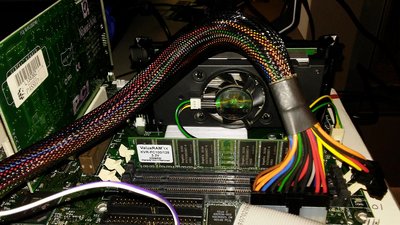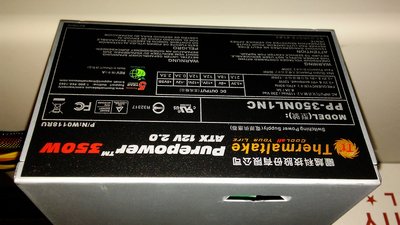Looks like you have quite a bit to learn - but you're going about it the right way 😀
Regarding your questions/comments:
Have not hooked up a hard/floppy drive yet as didn't know if that mattered
Good. When testing, keep it as simple as possible. Just PSU, CPU, motherboard, one DIMM, a video card and a keyboard. Nothing else. If that works, fine, hook up other stuff, but if not don't complicate matters with unnecessary hardware.
Something to note. I've been using one of those cheap power "button" switches to start it instead of the "screw driver" method. It's labeled as a reset
switch, does that matter?
All the power button does is short two pins. Anything that connects the two electrically is fine, be it a screwdriver, reset switch, coin or that metal bit that broke off your motorcycle last week 😜
Important: it only needs to briefly connect the pins. Keeping the pins shorted for 5 sec does a hard power off. Make sure whatever you use returns to the 'off' position as soon as things come alive. That's why I for one like the screwdriver.
Tried switching the ram going from SDRAM DDR 133mhz to 100mhz model but no change
Do you have the exact specs for those DIMMs? The i440BX is not hugely choosy, but as with other Intel chipsets, it refuses memory chips with 4 data lines (i.e. on DIMMs with 16 chips with 16Mx4 structure, so single-sided 128MB despite chips on both sides of the physical DIMM) and they were pretty common in the PC133 era and there existed such PC100 DIMMs too. I would expect some memory-related beeps if this were the problem, but it's worth double-checking.
Checked the ps (which is nos) with the paper clip method and it checked out.
Not quite. That test shows it can respond to a power on signal and can deliver something resembling power, but it by no means proves correct voltage on all the supply lines. Fans will turn with half their usual 12V, LEDs will generally turn on even if the +5V line (that feeds the CPU on boards from this era) is below 4V, and neither says anything about the state of the +3.3V line. Only consider the PSU known-good if it works flawlessly with another system with similar or higher power draw. And/or get out a voltage meter and see what it's delivering while the fans are turning.
Always a good idea, but if you've done it a few times already, it's not likely to help much. One point of special interest in a Slot 1 system: the CPU. If the SECC retention mechanism doesn't fit snugly (perhaps because you're using an So370-Slot 1 adapter card) having the CPU wobbling can ruin stability or even the ability to boot.
2. Clean cpu/ram connections
Possibly, but be VERY careful. Static electricity (ESD) can easily kill electronics. Make sure you are completely earthed, not wearing any synthetic or wool garments, and use a natural rubber for cleaning the connectors. TBH unless the connectors seem specifically dirty or corroded this is unlikely to make a difference anyway.
3. Hook up a floppy drive
Not until you've done anything else. Only reason to hook up an FDD to a board that doesn't post is to do an emergency recovery BIOS flash. It's been so long since I worked with the Intel Seattle I forget the exact procedure, but basically you hook up with FDD only and a specially prepared floppy in it, then if you're lucky a borked BIOS might recover itself.
4. Try it inside a case. Currently the mobo is on a box, seen others do it.
For good reason. A case is another source of uncertainty (short circuits due to incorrect standoffs etc) and makes messing around with the board more challenging. Outside of a case you should theoretically use certified ESD-safe mats. If you have one, by all means use it, but fortunately for the rest of us, a sheet of thick cardboard or a pile of newspapers have almost exactly the same electrical characteristics (conductivity so bad they for all intents insulate, but just enough to prevent the build-up of and allow safe bleeding of any static charges). Engineers have been known to use cardboard instead of ESD-mats in lab environments in fact I assisted a vendor's QA engineer with a convenient-sized piece for this very purpose this afternoon. A box is useful simply because the video card sticks out below the motherboard so you want an edge. Much, much better than messing around inside a case. Save that for when the board is working correctly 😉
Unless the CPU is known-good, this is a good step. Basically distrust every component until you know for sure it works and is compatible with this board. Memory or video cards issues *should* cause beeps rather than completely no signal, but make no assumptions. A bad CPU or PSU would definitely not cause beeps, so they are the prime suspects. Even double-check the keyboard in a different system in case of any doubt.
A couple of things.
Two tools that are very nice to have for this sort of situation:
- a voltage meter (or better, a multimeter that can also measure resistance)
- an ISA or PCI POST-card that can show BIOS POST codes even if there is no display
By checking the voltage between the various power lines and GND you can get a good indication of how the PSU is behaving. Given your description it's likely the POST display would stay at 00 regardless, but maybe not. You can look up the meaning of the codes depending on the BIOS vendor.
Generally the two commonest causes of totally not booting of a board (other than obvious physical damage) are either bad caps or a bad BIOS flash (or as the boards get older, a corrupt BIOS chip). Intel generally uses very high-quality caps, so I'd be surprised if that was the problem here, but I have been surprised before - last week I had a 1997-vintage Asus board with unmistakable bulging caps. BIOS issues are a pain in this case as Intel has soldered flash memory onto the board rather than using a socketed BIOS. That means you can't hot-flash (flash a replacement chip on another running board), so the official BIOS recovery via floppy is the only option here in that case (unless you are good at SMD soldering and have some way of hooking that chip up to a programmer...)
Another thing: use all your senses. That Asus board I mentioned also failed to boot completely. It had some bad caps but that wasn't the big issue. By smell alone I knew something was seriously wrong the instant I switched it on - the smell of extremely unhappy electronics is unmistakable. I found the cause afterwards by the heat one chip was generating - the northbridge had completely burned through and was even cracked. When I knew where to look it was visible, not just on the board, but also on the eBay listing. But it was the feeling of heat as my hand passed over the board that told me where to look.

